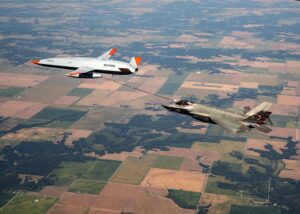The Navy is developing several unmanned aerial vehicles (UAVs) as it works on the air wing of the future for aircraft carriers beyond the unmanned carrier-based tanker it expects to deploy later this decade.
Rear Adm. Andrew Loiselle, the director of the Air Warfare Division, N98, this week underscored the air wing of the future will be operating at ranges “that vastly exceed what we’re doing today. And so in order to do that, unmanned portfolio really needs to be part of that system, because it’s the easiest way for us to keep a normally sized aircraft, but then have all of that extra space for fuel that gets us the range that we require to be able to get out there and play with some of the aircraft that are under development right now, at vastly higher ranges.”
Loiselle explained his perspective on future unmanned aircraft while speaking on July 13 during an event hosted by the U.S. Naval Institute and Center for Strategic and International Studies.
While he was unwilling to disclose specific capabilities or projects beyond the Boeing [BA] MQ-25A Stingray tanker, Loiselle said when he considers future unmanned aircraft on an aircraft carrier he divides them into three sets.
“The first set is something that can go into a hostile environment, high threat environment, and it can stay there, it can persist in a high threat environment. The second set is something that can go to that high threat environment, perform a given mission briefly, i.e. a strike mission, and then leave and have a very high chance of coming home.”
“And then the last set is something that is at an attritable price point, a much smaller vehicle that might perform any number of different missions, anything from going out there with our fighter aircraft and carrying more air to air missiles for those types of missions. Or we might someday integrate that type of thing into our electronic warfare, a distributed architecture that will conduct that mission. And then we might also use those same types of drones for a distributed command and control network,” he continued.
When asked if any of these UAVs under development are part of the Navy’s Next Generation Air Dominance (NGAD) development, Loiselle said not exclusively.
“I would say no…and the reason I say no, isn’t that they wouldn’t be used within NGAD, it’s that they are not exclusively for that platform. Okay, there’s equal applicability in the manned-unmanned teaming concept for any small UAS to be used with any aircraft on our flight deck. It’s not limited to that one capability.”

Unlike the Air Force, the Navy has kept its 6th generation NGAD fighter program budget levels classified since the FY ‘20 budget request. That year the Navy requested $20.7 million in funding and projected spending about $256 million in FY ‘22. In contrast, the Air Force is requested almost $1.7 billion for its NGAD research and development account in FY ‘23.
When the Defense Department budget request was released in March, Rear Adm. John Gumbleton, Deputy Assistant Secretary of the Navy for Budget, told reporters “NGAD is a classified program and I would tell you funding increase is going up also over the FYDP, but we are choosing to keep that value classified.”
He added that over the five-year Future Years Defense Program the NGAD budget line goes up “somewhat dramatically” (Defense Daily, March 28).
For now, Loiselle highlighted the importance of the MQ-25A as the next step in unmanned operations and extending naval aviation ranges.
“Under development right now we have the MQ 25, which is first envisioned as a tanker. And so that’s its primary role in its initial instantiation. And so we expect that to be out making its first deployment in the [2026] timeframe. And so they are real. And in there are several other things under development right now that I’m very excited about,” he said.
When asked about operations the MQ-25 will undertake, Loiselle said the Navy has not yet nailed down the “exact concept of operations for exactly what we’ll do with that airframe,” but it will be the recovery tanker for six to 10 cycles in a row. In contrast, the current F/A-18E/F Super Hornets acting as tankers perform in one pattern per event.
“So it’s going to be out there for a good bit longer,” Loiselle said.
The first operational MQ-25A Stingray tankers are expected to deploy aboard the USS Theodore Roosevelt (CVN-73) by 2026.
Loiselle noted the aircraft can pass about 15,000 pounds of gas up to 500 nautical miles away from the carrier, freeing up the Super Hornets currently used for tanking as additional strike aircraft.
Vice Adm. Kenneth Whitesell, Commander of Naval Air Forces and Naval Air Force, U.S. Pacific Fleet, clarified where the Navy is with MQ-25 right now.
“It’s going to extend the range of force for the carrier. And then [in] extremis how we use it. We’ve done the thought piece now on getting it off the carrier, getting it back…for that now we’re talking to think about where’s it going to stack? Where does it go? Is it going starboard delta? Where’s it recovered at the time? Where are we going to park the numbers that we want to put on the carrier…So we’re not just jumping into this uninformed today, we’re working towards a model. IOC is coming up in ‘25.”
Last December, The Navy completed tests controlling the first MQ-25 test asset built by Boeing, called T-1, aboard the USS George H.W. Bush (CVN-77) for deck handling operations. This did not include any flight tests off the carrier (Defense Daily, Dec. 20, 2021).
The Navy expects the first engineering and manufacturing aircraft model of the MQ-25 to be delivered this fall or winter. That aircraft will then conduct carrier-based flight tests.